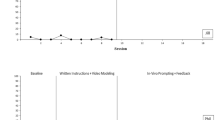Abstract
Graphic communication modes are often considered for children with multiple disabilities as an alternative to speech or gestures. However, there have been few empirical studies demonstrating effective procedures for teaching graphic mode requests to young children with multiple disabilities. In the present study, two children with multiple disabilities were taught to request preferred food and drink items by pointing to corresponding line drawings. Time-delay, prompting, reinforcement, and error correction procedures were implemented in a multiple-probe design to establish discriminated and generalized requests for preferred foods and beverages during morning snack time. The procedures were effective in teaching generalized and discriminated use of the food and drink symbols. Although effective in teaching children to request offered items, the procedures used in the present study need further development to ensure requests are controlled by the more natural conditions of hunger and thirst.
Similar content being viewed by others
References
Albin, R. W., and Horner, R. H. (1988). Generalization with precision. In Horner, R. H., Dunlap, G., and Koegel R. L. (eds.),Generalization and Maintenance: Life-style Changes in Applied Settings, Paul H. Brookes Publishing Co., Baltimore, pp. 99–120.
Bates, E. (1976).Language and Context: The Acquisition of Pragmatics, Academic Press, New York.
Butterfield, N., Arthur, M., and Sigafoos, J. (1995).Partners in Everyday Communicative Exchanges, MacLennan and Petty, Sydney.
Chadsey-Rusch, J., and Halle, J. (1992). The application of general-case instruction to the requesting repertoires of learners with severe disabilities.J. Assoc. Pers. Sev. Hand. 17: 121–132.
Cipani, E. (1988).Behavior Analysis Language Program: Theory, Assessment, and Training Practices for Personnel Working with People with Severe Handicaps, Edmark Corporation, Bellevue, WA.
Compic Development Association (1986).Compic Pictographs, Compic Development Association, North Balwyn, Victoria.
Duker, P. C., and Remington, B. (1991). Manual sign-based communication for individuals with severe or profound mental handicap. In Remington, B. (ed.),The Challenge of Severe Mental Handicap: A Behaviour Analytic Approach, John Wiley & Sons, Chichester, pp. 167–187.
Duker, P. C., and van Lent, C. (1991). Inducing variability in communicative gestures used by severely retarded individuals.J. Appl. Behav. Anal. 24: 379–386.
Goetz, L., and Hunt, P. (1994). Augmentative and alternative communication. In E. Cipani, E., and Spooner, F. (eds.),Curricular and Instructional Approaches for Persons with Severe Disabilities, Allyn & Bacon, Boston, pp. 263–288.
Glennen, S. L., and Calculator, S. N. (1985). Training functional communication board use: A pragmatic approach.Augment. Alter. Comm. 1: 134–142.
Gobbi, L., Cipani, E., Hudson, C., and Lapenta-Neudeck, R. (1986). Developing spontaneous requesting among children with severe mental retardation.Ment. Retard. 24: 357–363.
Guess, D., Sailor, W., and Baer, D. M. (1974). To teach language to retarded children. In Schiefelbusch, R. L., and Lloyd, L. L. (eds.),Language Perspectives: Acquisition, Retardation, and Intervention, University Park Press, Baltimore, pp. 529–563.
Halle, J. W. (1987). Teaching language in the natural environment: An analysis of spontaneity.J. Assoc. Pers. Sev. Hand. 12: 28–37.
Horner, R. D., and Baer, D. M. (1978). Multiple-probe technique: A variation of the multiple-baseline.J. Appl. Behav. Anal. 11: 189–196.
Lovaas, O. I. (1977).The Autistic Child: Language Development Through Behavior Modification, Irvington Publishers, New York.
McCook, B., Cipani, E., Madigan, K., and LaCampagne, J. (1988). Developing requesting behavior: Acquisition, fluency, and generality.Ment. Retard. 26: 137–143.
Michael, J. (1985). Two kinds of verbal behavior plus a possible third.Anal. Verbal Behav. 3: 1–4.
O'Neill, R. E. (1990). Establishing verbal repertoires: Toward the application of general case analysis and programming.Anal. Verbal Behav. 8: 113–126.
Reichle, J., and Brown, L. (1986). Teaching the use of a multi-page direct selection communication board to an adult with autism.J. Assoc. Pers. Sev. Hand. 11: 68–73.
Reichle, J., York, J., and Sigafoos, J. (1991).Implementing Augmentative and Alternative Communication: Strategies for Learners with Severe Disabilities, Paul H. Brookes Publishing Co., Baltimore.
Romski, M. A., Sevcik, R. A., and Pate, J. L. (1988). Establishment of symbolic communication in persons with severe mental retardation.J. Speech Hear. Disorders 53: 94–107.
Sailor, W., and Mix, B. (1975).The Topeka Association for Retarded Citizen's Assessment System, Pro-ed, Austin, TX.
Saunders, K. J., and Spradlin, J. E. (1989). Conditional discrimination in mentally retarded adults: The effects of training the component simple discriminations.J. Exp. Anal. Behav. 52: 1–12.
Schnaitter, R. (1978). Private causes.Behaviorism 6: 1–12.
Shafer, E. (1993). Teaching topography-based and selection-based verbal behavior to developmentally disabled individuals: Some considerations.Anal. Verbal Behav. 11: 117–133.
Sigafoos, J. (1995). Testing for spontaneous use of requests after sign language training with two severely handicapped adults.Behav. Interven. 10: 1–16.
Sigafoos, J., Couzens, D., Pennell, D., Shaw, D., and Dudfield, G. (1995). Discrimination of picture requests for missing items among young children with developmental disabilities.J. Behav. Educ. 5: 295–317.
Sigafoos, J., and Reichle, J. (1992). Comparing explicit to generalized requesting in an augmentative communication mode.J. Develop. Phys. Disabil. 4: 167–188.
Sigafoos, J., and Reichle, J. (1993). Establishing spontaneous verbal behavior. In Gable, R. A., and Warren, S. F. (eds.),Advances in Mental Retardation and Developmental Disabilities, Vol. 5: Strategies for Teaching Students with Mild to Severe Mental Retardation, Jessica Kingsley, London, pp. 191–230.
Skinner, B. F. (1945). The operational analysis of psychological terms.Psych. Review 52: 270–277.
Skinner, B. F. (1956). A case history in scientific method.Amer. Psych. 11: 221–233.
Sundberg, M. L. (1980).Developing a Verbal Repertoire Using Sign Language and Skinner's Analysis of Verbal Behavior, Western Michigan University, Kalamazoo, MI, Unpublished doctoral dissertation.
Sundberg, M. L. (1993). Selecting a response form for nonverbal persons: Facilitated communication, pointing systems, or sign language?Anal. Verb. Behav. 11: 99–116.
Turnell, R., and Carter, M. (1994). Establishing a repertoire of requesting for a student with severe and multiple disabilities using tangible symbols and naturalistic time delay.Aust. New Zealand J. Develop. Disabil. 19: 193–207.
Author information
Authors and Affiliations
Rights and permissions
About this article
Cite this article
Sigafoos, J., Couzens, D., Roberts, D. et al. Teaching requests for food and drink to children with multiple disabilities in a graphic communication mode. J Dev Phys Disabil 8, 247–262 (1996). https://doi.org/10.1007/BF02578393
Issue Date:
DOI: https://doi.org/10.1007/BF02578393




